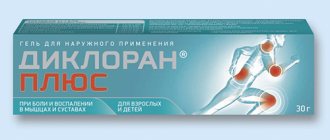Indications and contraindications for the use of Hydrocortisone
As a component of systemic and replacement therapy, the drug is indicated for the following conditions: adrenal insufficiency, shock of various origins, hepatic coma, allergic laryngeal edema, status asthmaticus, exacerbation of Crohn's disease and ulcerative colitis, gouty, rheumatoid and psoriatic arthritis, SLE, dermatomyositis.
Local use of the drug is indicated for eczema, various dermatitis, psoriasis, scabies, and insect bites.
Eye ointment is used to treat chronic or allergic blepharoconjunctivitis, acute keratitis, anterior and posterior uveitis, and burns of the ocular surface.
Contraindications to the systemic administration of Hydrocortisone are a history of allergic reactions, epilepsy, hypertensive crisis, Itsenko-Cushing syndrome and disease, osteoporosis, peptic ulcer and duodenal ulcer, diabetes mellitus type 1 and 2, HIV infection, pregnancy, lactation, and childhood.
Skin ointment should not be used for malignant neoplasms, syphilis, tuberculosis, viral, fungal and bacterial local infections.
The ophthalmic form of Hydrocortisone should not be prescribed for violations of the integrity of the cornea, infectious diseases, or trachoma.
Contraindications
Hypersensitivity to hydrocortisone or other components of the drug, wound, ulcerative skin lesions, bacterial, viral and fungal skin diseases, skin tuberculosis and syphilitic skin lesions. Rosacea, acne vulgaris, perioral dermatitis, skin tumors, pregnancy, breastfeeding, children under 2 years of age.
Carefully
Diabetes mellitus, tuberculosis (systemic damage).
Use during pregnancy and breastfeeding
The drug is contraindicated during pregnancy and breastfeeding.
Side effects and symptoms of overdose
Hydrocortisone when administered intramuscularly, intravenously and intraarticularly can provoke the appearance of edema, the development of heart failure, arrhythmia, osteoporosis and bone fractures, medicinal ulcers of the digestive tract, increased blood and intracranial pressure, muscle cramps, a decrease in the body's defenses, Itsenko-Cushing syndrome.
Skin ointment most often causes the following undesirable reactions: local redness, irritation, dryness, itching, burning, swelling and atrophy.
Use of the ophthalmic form of Hydrocortisone can lead to mixed injection, eyelid eczema, exophthalmos, cataracts, hormonal glaucoma, and corneal perforation.
An overdose of the drug is manifested by increased side effects, the appearance of dyspeptic syndrome and a violation of the general condition of the body.
In such a situation, it is important to gradually discontinue hydrocortisone and carry out competent symptomatic therapy.
Hydrocortisone
Interacts with specific cytoplasmic receptors (receptors for glucocorticosteroids (GCS) are found in all tissues, especially in the liver) to form a complex that induces the formation of proteins (including enzymes that regulate vital processes in cells).
Protein metabolism: reduces the amount of globulins in plasma, increases albumin synthesis in the liver and kidneys (with an increase in the albumin/globulin ratio), reduces synthesis and increases protein catabolism in muscle tissue.
Lipid metabolism: increases the synthesis of higher fatty acids and triglycerides, redistributes fat (fat accumulation occurs mainly in the shoulder girdle, face, abdomen), leads to developed hypercholesterolemia.
Carbohydrate metabolism: increases the absorption of carbohydrates from the gastrointestinal tract; increases the activity of glucose-6-phosphatase (increasing the flow of glucose from the liver into the blood); increases the activity of phosphoenolpyruvate carboxylase and the synthesis of aminotransferases (activation of gluconeogenesis); promotes the development of hyperglycemia. Water-electrolyte metabolism: retains Na+ and water in the body, stimulates the excretion of K+ (mineralocorticoid activity), reduces the absorption of Ca2+ from the gastrointestinal tract, causes “leaching” of calcium from the bones and increases its renal excretion, reduces bone mineralization.
The anti-inflammatory effect is associated with inhibition of the release of inflammatory mediators by zosinophils and mast cells; inducing the formation of lipocortins and reducing the number of mast cells that produce hyaluronic acid; with a decrease in capillary permeability; stabilization of cell membranes (especially lysosomal) and organelle membranes. Acts on all stages of the inflammatory process: inhibits the synthesis of prostaglandins (Pg) at the level of arachidonic acid (lipocortin inhibits phospholipase A2, suppresses the liberation of arachidonic acid and inhibits the biosynthesis of endoperoxides, leukotrienes, which contribute to the processes of inflammation, allergies, etc.), the synthesis of “pro-inflammatory cytokines" (interleukin 1, tumor necrosis factor alpha, etc.); increases the resistance of the cell membrane to the action of various damaging factors.
The immunosuppressive effect is caused by the involution of lymphoid tissue, inhibition of the proliferation of lymphocytes (especially T lymphocytes), suppression of the migration of B cells and the interaction of T and B lymphocytes, inhibition of the release of cytokines (interleukin-1, 2; interferon gamma) from lymphocytes and macrophages and decreased antibody formation.
The antiallergic effect develops as a result of a decrease in the synthesis and secretion of allergic mediators, inhibition of the release of histamine and other biologically active substances from sensitized mast cells and basophils, a decrease in the number of circulating basophils, T- and B-lymphocytes, mast cells, suppression of the development of lymphoid and connective tissue, decreased sensitivity of effector cells to mediators, allergies, inhibition of antibody formation, changes in the body's immune response.
In obstructive diseases of the respiratory tract, the effect is mainly due to inhibition of inflammatory processes, prevention or reduction of the severity of swelling of the mucous membranes, reduction of eosinophilic infiltration of the submucosal layer of the bronchial epithelium and deposition of circulating immune complexes in the bronchial mucosa, as well as inhibition of erosion and desquamation of the mucosa. Increases the sensitivity of beta-adrenergic receptors of small and medium-sized bronchi to endogenous catecholamines and exogenous sympathomimetics, reduces the viscosity of mucus by reducing its production.
Suppresses the synthesis and secretion of ACTH and, secondarily, the synthesis of endogenous corticosteroids. Inhibits connective tissue reactions during the inflammatory process and reduces the possibility of scar tissue formation.
Instructions for use of Hydrocortisone
Skin ointment is applied to the affected areas in a thin layer 2 to 3 times a day. The course of treatment is no more than 3 weeks, otherwise the likelihood of side effects increases.
Hydrocortisone-POS (ophthalmic form) is placed in a strip into the lower conjunctival sac up to 3 times a day. The duration of treatment is no more than 14 days. When using eye drops simultaneously, apply the ointment after them 10 minutes later.
A single dose of Hydrocortisone for systemic therapy is from 50 to 300 mg, and a daily dose is from 1000 to 1500 mg. The required amount of the drug is determined by the attending physician, based on the severity of the underlying disease and the presence of concomitant diseases. The frequency of administration and duration of therapy are also selected individually.
Hydrocortisone
If any of the side effects indicated in the instructions worsen, or any other side effects not listed in the instructions are noted, you should immediately inform your doctor.
Overdose
Acute overdose is unlikely, however, when using the drug on large areas of affected skin with increased capacity for resorption, for a long time or using an occlusive dressing, chronic overdose is possible, accompanied by signs of hypercortisolism.
Treatment: symptomatic, if necessary, correction of water and electrolyte balance, drug withdrawal (with long-term therapy - gradual withdrawal).
Interaction with other drugs
No interaction of Hydrocortisone when used externally with other drugs has been identified.
special instructions
If there are signs of hypersensitivity or skin irritation associated with the use of the drug, you should stop treatment and consult a doctor. With long-term treatment, when applying the drug to large surfaces of the skin, when using occlusive dressings, and also in children, systemic absorption of the glucocorticosteroid is possible: suppression of the function of the hypothalamic-pituitary-adrenal system and the development of symptoms of hypercortisolism are possible. Atrophic changes may appear on the skin of the face more often than on other surfaces of the body after long-term treatment with topical glucocorgicosteroids; the course of treatment in this case should not exceed 5 days.
Care must be taken when applying the drug to the face, folds, natural folds, and areas with thin skin.
Avoid getting the drug into your eyes. Do not apply the drug to mucous membranes.
It should be borne in mind that glucocorticosteroids can change the manifestations of some skin diseases, which can complicate the diagnosis. In addition, the use of glucocorticosteroids may delay wound healing. With long-term therapy with glucocorticosteroids, sudden cessation of therapy can lead to the development of rebound syndrome, which manifests itself in the form of dermatitis with intense redness of the skin and a burning sensation. Therefore, after long-term treatment, drug withdrawal should be carried out gradually, for example, by transferring to an intermittent treatment regimen before stopping it completely. Propyl parahydroxybenzoate, which is part of the drug, can cause allergic reactions (possibly of a delayed type). In such cases, you should stop using the drug.
Drug interactions
The effectiveness of Hydrocortisone when used systemically can be reduced by drugs of the following pharmacological groups:
- Antihistamines.
- Diuretics.
- Anticonvulsants.
Taking this drug together with non-steroidal anti-inflammatory drugs significantly increases the risk of drug ulcers.
Hydrocortisone reduces the effectiveness of glucose-lowering medications, and its simultaneous use with amphotericin B provokes the development of cardiovascular failure.
special instructions
In cases of use of the drug in children, on the face area under occlusive dressings, the duration of the course of treatment should be reduced to two weeks. In childhood, suppression of adrenal function may develop more quickly. In addition, a decrease in the secretion of growth hormone somatropin may be observed. For children from 2 to 12 years of age, the drug should be used only after consultation with a doctor and then under medical supervision.
Avoid contact of the ointment with the eyes and mucous membranes.
If after 7 days of use there is no improvement or worsening of the condition, the use of the drug should be stopped and consult a doctor. If symptoms recur a few days after stopping the drug, you should consult your doctor.
For long-term treatment and/or application to large surfaces, it is recommended to prescribe a diet with limited sodium and high potassium content; introduce a sufficient amount of protein into the body. It is necessary to monitor blood pressure, blood glucose, blood clotting, diuresis, the patient’s body weight, and plasma cortisol concentration.
To prevent infectious lesions, the drug is recommended to be prescribed in combination with antibacterial and antifungal agents.
Impact on the ability to drive vehicles and operate machinery
During treatment with the drug, caution should be exercised when driving vehicles and engaging in other potentially hazardous activities that require increased concentration and speed of psychomotor reactions.



